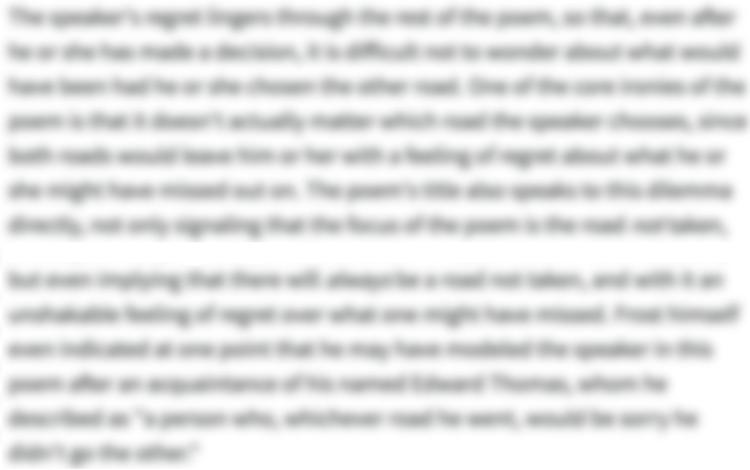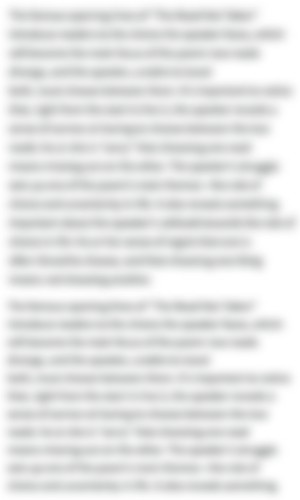The Full Text of “The World Is Too Much With Us”
1The world is too much with us; late and soon,
2Getting and spending, we lay waste our powers;—
3Little we see in Nature that is ours;
4We have given our hearts away, a sordid boon!
5This Sea that bares her bosom to the moon;
6The winds that will be howling at all hours,
7And are up-gathered now like sleeping flowers;
8For this, for everything, we are out of tune;
9It moves us not. Great God! I’d rather be
10A Pagan suckled in a creed outworn;
11So might I, standing on this pleasant lea,
12Have glimpses that would make me less forlorn;
13Have sight of Proteus rising from the sea;
14Or hear old Triton blow his wreathèd horn.
-
“The World Is Too Much With Us” Introduction
-
“The world is too much with us” is a sonnet by William Wordsworth, published in 1807, is one of the central figures of the English Romantic movement. The poem laments the withering connection between humankind and nature, blaming industrial society for replacing that connection with material pursuits. Wordsworth wrote the poem during the First Industrial Revolution, a period of technological and mechanical innovation spanning the mid 18th to early 19th centuries that thoroughly transformed British life.
-
-
“The World Is Too Much With Us” Summary
-
The material world—that of the city, our jobs, our innumerable financial obligations—controls our lives to an unhealthy degree. We are always rushing from one thing to the next; we earn money one day just to spend it the next. The result of this is that we have destroyed a vital part of our humanity: we have lost the ability to connect with and find tranquility in nature. In exchange for material gain, we have given away our emotions and liveliness. This ocean that reflects the moonlight on its surface, and the peaceful, momentarily windless night, which is like flowers whose petals are folded up in the cold—these natural features still exist, but we just can’t appreciate them. Our lives have nothing to do with the rhythms of the natural world. As a result, those rhythms have no emotional impact on us.
My God, I wish that I were raised in a culture that worshipped many gods, though that religion is now outdated. That way, standing on this pleasant patch of grass, I might be calmed and heartened by the image of the ocean before me. I might see the Greek god Proteus taking shape before my very eyes, or hear another Greek god, Triton, blow his legendary, spiral-grooved conch shell.
-
-
“The World Is Too Much With Us” Themes
-
Nature, Materialism, and Loss
In “The World Is Too Much With Us,” the speaker describes humankind’s relationship with the natural world in terms of loss. That relationship once flourished, but now, due to the impacts of industrialization on everyday life, humankind has lost the ability to appreciate, celebrate, and be soothed by nature. To emphasize this central loss, the poem describes it from three angles: economic, spiritual, and cultural. Notably, the poem does not suggest a way to regain what is lost. Rather, its tone is desperate, arguing that humankind’s original relationship with nature can never be revived.
The poem first presents loss in the economic sense, implicitly blaming urban life for the change in people’s relationship with nature. Because the urban world has “too much” control over our lives, we are always “late and soon” or “Getting and spending.” Modern humans are always losing time or money. As working people in an increasingly urban area, their lives are structured by a never ending series of appointments and transactions.
This lifestyle comes at a price: it destroys our power to identify with nature, or to appreciate the world around us. By focusing their “powers” on material objects, people grow unaware of their wider, and arguably more important, surroundings. The result is that nothing in nature—or elsewhere—is “ours.” This is a world where everything—be it a house, stocks in a company, or a loaf of bread—can be won or lost in an instant. By describing nature as something that can be owned or possessed, the speaker may be implying that modern human beings have lost the ability to think of relationships and emotions in anything but economic terms.
The poem next dwells on spiritual loss, though without forgetting that loss’s economic roots. “We have given our hearts away,” the speaker says. Though it uses economic language—people give something away in exchange for something else—this line adds another perspective to the depiction of loss. The price of material gain and industrial progress is the human heart itself, a symbol of life and emotion. In exchange, people receive a “boon”—that is, they gain something. Yet what they gain is “sordid”—it is dirty and immoral. In exchange for industrial progress, people have reduced themselves to an almost less-than-human state. The speaker suggests that this loss of humanity outweighs the material gain. As a result “we are out of tune” and nature “moves us not.” People have fallen from an ideal, natural state into one of disrepair. Having given away their ability to access deep, enduring emotions, they are numb to the beauty of the natural world, spiritually unmoved by it.
In its final lines the poem describes a cultural loss, and its tone of resignation suggests the loss is permanent. The speaker invokes Greek paganism, introducing a version of society in which nature played a larger role in human life. But the pagan tradition is “a creed outworn”—it’s a relic, and no longer useful. Once the speaker acknowledges the uselessness of past traditions, his or her wishes come across as more fanciful than serious. “I’d rather be a Pagan” and “So might I” do not represent what the speaker believes is possible, but rather what he or she wishes were still possible.
As a member of modern society, the speaker cannot access nature in a way to make him- or herself “less forlorn.” This doesn’t mean that nature has been destroyed; the “pleasant lea” still exists, it just doesn’t soothe the speaker. At this moment of emotional despair, the best he or she can do is imagine a past that, in its fullest form, is lost and inaccessible.
- See where this theme is active in the poem.
-
The Individual vs. Society
The poem explores how modernity has eroded not just people’s connection to nature, but also people's sense of individual identity and agency. The poem subtly suggests that modern city life has lead to a sort of uniformity of experience, and that individuals are powerless to resist society’s homogenizing effects.
The poem’s first eight lines notably make use of the collective pronoun "we" as they reveal how, as society grows, the individual fades. In industrial society, “we lay waste our powers.” A power, skill, or ability is something that might distinguish an individual, but in an industrial society focused on material gain, those distinguishing characteristics disappear. As a result, everyone meets the same fate: “Little we see in Nature that is ours.” The speaker suggests that the natural world used to function as a sort of mirror in which humans could learn about themselves—a tranquil counterbalance to the chaotic city, and which encouraged self-reflection. As humans grow apart from nature, the poem suggests, they lose that space for self-reflection.
What's more, the speaker insists that “We have given our hearts away.” Again, the speaker describes an abstract, collective act, this time of every person giving away their heart—everything they personally care for—in the name of supposed progress. This reveals a sense of individual suffering and loss beneath sweeping societal change.
With the pronoun “we” in the poem's first half, the speaker thus describes how industrial life has isolated people in general from nature and partially erased their unique identities. With the switch to “I” in the second half, the speaker attempts to respond to those changes—and in doing so, provides an example of a person living within that industrialized society.
Yet this first-person speaker offers no solution to the problem presented in the first lines. Instead, he or she suggests that the individual is essentially helpless in the face of broad societal change through the allusions to the mythical Greek gods Proteus and Triton. In a context that showed more faith in the Greek tradition, these gods might actually represent the power of the individual. Proteus, with his ability to constantly change form, could stand for individual versatility. Triton, with his ability to lift waves by blowing his conch, might represent human strength. But having acknowledged the uselessness of the Greek tradition, the speaker regards these powers as pure fantasy. Thinking about them while “standing on this pleasant lea” doesn’t constitute an act of individual imaginative defiance, but of pointless idleness.
What Proteus and Triton do represent is the individualism inherent to a society that worshipped many gods, each with unique identities and means of worship. These ancient mythical figures contrast with the Christian God—a single entity, the worship of whom homogenizes religious activity in much the same way that industrialization and the thirst for material gain homogenize life within a big, industrialized city.
The perspective of the final lines, which looks out upon a limitless ocean horizon, might suggest the possibility of a fresh, more hopeful set of relationships between the individual, society, and nature. But if that’s the case, then it’s no more than that—a suggestion. Regardless of how the speaker goes on to change his or her perspective, the poem's final tone is one of dejection.
- See where this theme is active in the poem.
-
-
Line-by-Line Explanation & Analysis of “The World Is Too Much With Us”
-
Lines 1-2
The world is too much with us; late and soon,
Getting and spending, we lay waste our powers;—The first two lines introduce the poem’s problem, characters, and central confusion—namely, that the world contains the city and nature, but doesn’t seem to actually have room for both.
As an Italian sonnet, the poem's form dictates that it begin with a problem, or “proposition,” and it does so pretty clearly in its opening statement: “The world is too much with us.” (This is also used as its title, though it should be noted that the poem was first published without a title at all). This problem, however, doesn’t have an obvious meaning when considered on its own.
First of all, “world” could refer to the natural world, some world in the imagination, a world created by human beings, or Earth as a whole. “Too much” also garners multiple readings. Is the world just simply “too much,” unbearable and overfull with this many people? Or are those people carrying around the burdens of the world too often, too much of the time?
The ambiguity is a deliberate effort by the poem to blur the line between nature and civilization. This world, and its ambiguities, are too much with us, meaning humans, the ones who must suffer the effects of society’s growth and puzzle over its consequences. Even though the poem speaks for a collective “we,” and continues to do so for the rest of the octave, the end of line 1 and all of line 2 present a very individual perspective (though it is collective in the sense that it’s something nearly all individuals experience). The poem sums up human activity in this manmade world efficiently: humans are always late, soon, getting, and spending. Though abstract, these words have the power to recall vivid memories of waiting in lines, rushing to appointments, earning money for hard work and almost immediately giving it away. These words serve a metonymic function, then, as they represent all forms of economic activity by association.
The content of these lines is reflected in their meter and punctuation. The poem is written in iambic pentameter (five stressed and five unstressed syllables in an alternating pattern), though there is a fair amount of variation:
The world | is too | much with | us; late | and soon,
Getting | and spend- | ing, we | lay waste | our powers;—Note how the arguable stress on "much" leads to two stresses in a row; line 1 has too many stressed syllables in fact (six rather than five), sonically reflecting this "muchness." Line 2 is even more irregular, following a "DUM da da DUM da da" rhythm up top that seems to reflect a sense the tedium or monotony of "getting and spending," only to be abruptly stopped short by the double stress of "lay waste." The sudden spondee here (a foot consisting of two stressed syllables in a row) cuts this waltzing list short, a sharp reminder of the havoc such "getting and spending" is wreaking on people's lives.
The caesuras and end-stops in these lines heighten the frantic tone. A semicolon abruptly ends the opening statement, and at the end of line two, the clunky combination of a semicolon with an em-dash reflects the hindrances that city life imposes on humans. It might, by drawing attention to the punctuation, a tool invented by humans to better convey language, highlight the artificial nature of living in a city.
With its final clause, “we lay waste our powers,” line 2 hints at one of the poem’s central questions. Later on, the speaker will implicitly wonder whether there’s any chance humans can regain their “powers” and reconnect with nature. “Lay waste” describes the utter destruction of those powers. So, before the poem has fully expressed the problem, it offers an opinion about whether it can be solved.
-
Line 3
Little we see in Nature that is ours;


Unlock all 398 words of this analysis of Line 3 of “The World Is Too Much With Us,” and get the Line-by-Line Analysis for every poem we cover.
Plus so much more...
Get LitCharts A+ -
Line 4
We have given our hearts away, a sordid boon!
-
Lines 5-7
This Sea that bares her bosom to the moon;
The winds that will be howling at all hours,
And are up-gathered now like sleeping flowers; -
Lines 8-9
For this, for everything, we are out of tune;
It moves us not. -
Lines 9-10
Great God! I’d rather be
A Pagan suckled in a creed outworn; -
Lines 11-12
So might I, standing on this pleasant lea,
Have glimpses that would make me less forlorn; -
Lines 13-14
Have sight of Proteus rising from the sea;
Or hear old Triton blow his wreathèd horn.
-
-
“The World Is Too Much With Us” Symbols
-
Flowers
In line 7, the speaker compares the howling winds, for the moment inactive, to “sleeping flowers.” The main word that connects the two is “up-gathered.” Like a flower at night, whose petals are folded up, the winds are gathered away in some out-of-reach place and taking a rest. The “up-gathered” and “sleeping flowers” appear only in this one line, but the flower symbol modifies other parts of the poem. As something that is delicate, beautiful, and momentarily closed-up, the sleeping flower symbolizes humankind’s relationship with nature.
The symbol’s most striking aspect is its state of being closed. Unlike humans, who are “out of tune” with nature, the flower will follow natural processes—when the sun rises, it will presumably unfold. Yet the poem suggests that people's relationship with nature will not so easily regain its color and vitality. Given the poem’s pessimism, the reader might consider the fate of the up-gathered flower as uncertain. Maybe, instead of unfolding in the morning, it will wither and die. This fate seems to depend on humankind’s ability to reimagine its relationship with nature. The poem does not give a definitive word on where this relationship is headed—on whether the “flower” will flourish or die—but suggests with its desperate tone that what is lost cannot be regained.
- See where this symbol appears in the poem.
-
-
“The World Is Too Much With Us” Poetic Devices & Figurative Language
-
Caesura
The poem uses caesura in six lines to reflect both its subject matter and the speaker’s state of mind. These caesuras fall into two categories: hard and soft. Those aren’t technical terms. In this poem, we're using hard basically means an abrupt stop caused by a period, semicolon, or exclamation mark. We're using soft to mean a stop caused by a comma.
In line 1, a semicolon separates the opening statement from an elaboration on that statement. The opening statement expresses a problem: that human beings spend too much time in the manmade, industrial world. Immediately after this, the speaker gives examples of the effect that this problem has on the average city dweller: “late and soon, / Getting and spending, we lay waste our powers.” Arguably, however, the caesura itself is the first example of people’s unhealthy attachment to the fast-paced material world. Consumed by a fast-pace lifestyle, the speaker rushes headlong into “late and soon.”
Line 9 contains the other instance (actually, two instances) of a “hard” caesura. Nestled between a period and exclamation mark is the apostrophe, “Great God!,” which marks the border between the octave (the sonnet's first eight lines) and the sestet (the sonnet's final six lines). As in line 1, this disjointed line reflects the speaker’s scattered mindset. The period after "Moves us not" also emphasizes the finality of that statement.
In lines 2, 4, 8, and 11, commas break the flow of words. Less a reflection of the feelings of the speaker, these caesuras give the poem a dramatic effect. In line 8, for example, commas separate out “for everything” in order to linger on the cost humankind’s pursuit of material gain. In line 11, the caesura accommodates a specification of the speaker’s location, a “pleasant lea.”
- See where this poetic device appears in the poem.
-
End-Stopped Line


Unlock all 322 words of this analysis of End-Stopped Line in “The World Is Too Much With Us,” and get the poetic device analyses for every poem we cover.
Plus so much more...
Get LitCharts A+ -
Metonymy
-
Personification
-
Simile
-
Metaphor
-
Apostrophe
-
Anaphora
-
Assonance
-
Alliteration
-
Consonance
-
-
“The World Is Too Much With Us” Vocabulary
Select any word below to get its definition in the context of the poem. The words are listed in the order in which they appear in the poem.
- Lay waste
- Sordid
- Boon
- Bosom
- Up-gathered
- Pagan
- Suckled
- Creed outworn
- Lea
- Forlorn
- Proteus and Triton
- Wreathèd
Lay waste-
An archaic expression that means to destroy completely. For example, an army could lay waste a city. A child throwing a tantrum could lay waste his bedroom (though that’s a more hyperbolic, tongue-in-cheek example). The poem takes full advantage of the verb’s full meaning, as it describes a power being wasted. Thus, the word suggests that the power to appreciate nature is like a muscle: it is being destroyed because it is going to waste.
- See where this vocabulary word appears in the poem.
-
Form, Meter, & Rhyme Scheme of “The World Is Too Much With Us”
-
Form
“The world is too much with us” is an Italian sonnet, also known as a Petrarchan sonnet (named after Franceso Petrarca, the Italian Renaissance poet who popularized the form). These sonnets include an octave (two quatrains, or four-line stanzas) and a sestet (two tercets, or three-line stanzas). In this and all of Wordsworth’s sonnets, each unit is mashed together into a single 14-line stanza.
In the traditional Italian sonnet, the octave presents a problem, and the sestet responds to that problem. The problem is known as the “proposition,” and the transition into the resolution is known as the “turn.” In this poem, the problem is expressed pretty clearly in the title: “The world is too much with us.” The octave explains the problem and its consequences, namely that industrial society has killed humankind’s connection with nature. The sestet responds to the problem via the speaker's individual perspective.
In this poem, that transition to the sestet and this personal perspective is clearly marked. In the middle of the ninth line, the apostrophe “Great God!” breaks the somewhat meandering description of the moonlit ocean. The rest of the sestet is also clearly distinguished. Whereas the octave uses only first-person plural pronouns, the sestet uses only first-person singular pronouns.
-
Meter
The poem is written in iambic pentameter, (five stressed and five unstressed syllables in an alternating pattern: da DUM), which is no surprise. Most sonnets (and, in fact, most poetry) written in English at the time were. In his Preface to Lyrical Ballads, Wordsworth identifies meter as the main thing that distinguishes poetry from prose.
As is often the case, however, the poem does not stick to its meter exactly. Line 1, for example, can be read as containing a spondee (stressed-stressed) in its third foot, while line 2 opens with a trochee (stressed-unstressed), and then has another spondee later on:
The world | is too | much with | us; late | and soon,
Getting | and spend- | ing, we | lay waste | our powers;—Line 1 has an extra syllable (six rather than five, which is what pentameter would normally consist of), and thus reflects via meter this sense of "muchness." Line 2 creates a feeling of tedium with the waltzing DUM da da DUM da da (or ONE two three ONE two three) rhythm of "getting and spending," which is then stopped in its tracks the double stress of "lay waste." This echoes the way that all this "getting and spending" is "laying waste" to people's lives. (Note that line 2 also technically has 11 syllables, one extra, but at the time of writing "powers" would likely be elided to sound like a single syllable word; either way, this extra syllable is unstressed, creating a weak trailing off that echoes the fact that our "powers" are not being utilized properly.)
In the first eight lines, the steady iambic rhythm is often disrupted in order to emphasize keywords that signal the poem’s themes. When the poem breaks into descriptions of nature, the meter takes back over, almost completely. Take line 5:
This Sea | that bares | her bos- | om to | the moon;
In both lines, the poem distinguishes nature from the city. When describing city life, the speaker’s rhythm is rather erratic. Looking out at the moonlit ocean, his or her expression returns to the relatively smooth cadence of iambic pentameter.
-
Rhyme Scheme
“The world is too much with us” follows a rhyme scheme that’s typical of Italian sonnets. The first eight lines (or octave) form something like rhyme sandwiches, with one rhyme as bread and another as the filling:
ABBAABBA
The final six lines (or sestet) follow this rhyme pattern:
CDCDCD
The poem follows this scheme faithfully. That is, each rhyme is nearly perfect. A word like “powers” may be pronounced slightly differently than “ours” or “hours,” but any difference is extremely subtle (unlike some of the slant rhymes that Wordsworth uses in his other sonnets, like “Composed Upon Westminster Bridge”). This rigid adherence to the rhyme scheme might be interpreted as a reflection of the stultifying order of the industrial city.
In lines 6-8, the poem uses subtle internal rhyme with the participles (verb forms that act as adjectives) “howling” and “sleeping” and the pronoun “everything.” The -ing suffix extends the words. It slows the pace of the poem and thus gives the impression that the speaker is savoring this fleeting glimpse of natural beauty. "Howling" also chimes with "hours," adding a sense of music to a line appropriately focused on the noise of the wind.
-
-
“The World Is Too Much With Us” Speaker
-
The speaker in “The world is too much with us” is unidentified. No gender, name, or other identifying features are specified. Though it might be reasonable to assume that the speaker is Wordsworth himself, as many of his poems are indeed autobiographical, there’s simply not enough evidence in this poem to prove that's the case.
The poem is especially abstract—its subjects are the broader “world” (or city) and “Nature”—so it makes more sense to interpret the speaker as a general spokesperson for humankind right around the turn of the 19th century, when England was experiencing major industrial growth. In his or her role as spokesperson, the speaker takes on the issue of humankind’s relationship with nature from two perspectives.
In the first eight lines, the poem is spoken from the perspective of a collective “we.” In the final six, it’s spoken from the perspective of an “I.” The speaker is clearly distressed over the behavior of modern humans, seeing everything they’ve achieved as “a sordid boon.” But he or she maintains enough of an analytical mindset to approach the problem rationally, first by describing societal effects, then by considering an individual’s response to those effects. The speaker’s ordered way of thinking, or reason, however, does not relieve him or her of despair.
Nor does another intellectual faculty: the imagination. The speaker may be able to recall the world of Greek paganism, but he or she cannot revive it. For that reason, no “glimpses” will make the speaker “less forlorn.” Though Wordsworth may have had more faith in the power of the imagination, the speaker’s hopelessness seems to be permanent. Neither reason nor the imagination can soothe this stressed-out soul.
-
-
“The World Is Too Much With Us” Setting
-
The poem’s setting is unspecified, but it’s fair to say that it occupies both mental and physical territory. Let’s first take a look at the physical. By the end of the poem, it has become clear that the speaker does his or her speaking from a point in the natural world—specifically, a “pleasant lea,” or patch of grass, overlooking the ocean (in daydreaming about Greek paganism, the speaker pictures ocean gods). We also know that this is happening at night, as the poem’s first specific nature description is of a windless, moonlit scene.
The poem also occupies mental territory in that the speaker, though physically in nature, returns in his or her mind to the city. “The world” from the opening line refers to urban, industrial society. We know this because the speaker specifies by explaining what goes on in that world: “Getting and spending.” This is a clear reference to economic activity, which, at the turn of the 19th century, would have occurred in the center of economic activity: the city. Even though the speaker does not mention the city in the final lines, he or she has it in mind; its memory is what prevents a full appreciation of nature.
-
-
Literary and Historical Context of “The World Is Too Much With Us”
Literary Context
“The world is too much with us” was written in the first years of the 19th century and published in 1807, in a book called Poems, In Two Volumes. Critics consider Wordsworth to have been at the height of his creative powers around this time. Certainly it was when he was most popular, even if the book elicited a rather nasty review from the poet Lord Byron.
In 1795 Wordsworth met the poet Samuel Taylor Coleridge and two years later moved, with his sister Dorothy Wordsworth, also a poet, to live near him. In 1798, Wordsworth and Coleridge jointly published Lyrical Ballads. Containing Coleridge’s “The Rime of the Ancient Mariner” and Wordsworth’s “Tintern Abbey,” the book is considered to have gotten the English Romantic Poetry movement into full swing.
The work from this period, which some scholars call Wordsworth’s “great decade,” was characterized by a focus on natural imagery, poems that fit the definition of verse that Wordsworth set down in his Preface to Lyrical Ballads: “the spontaneous overflow of powerful feelings ... recollected in tranquillity.” “The world is too much with us,” then, contrasts with Wordsworth’s typical work at the time. The speaker seeks tranquility in nature, but doesn’t find it. Instead, he or she is overpowered by the rhythms of the city.
Other sonnets from Poems, In Two Volumes, such as “London, 1802,” regard industrial changes with similar despair, though another sonnet, “Composed upon Westminster Bridge,” offers a slightly more optimistic take—though it, too, is complicated. “London,” a 1794 poem by William Blake, is a precursor for “The world is too much with us” in that it fixates on the ugliness of industrial urban life.
Historical Context
The year of the poem’s publication, 1807, was a time of major social, political, and economic change for Great Britain and the world. In 1799, ten years after the French Revolution, Napoleon Bonaparte had seized power, and by 1803 had begun his march toward European domination. After a decade-long series of wars that ended with France’s defeat, Britain, which had financed and organized much of the resistance, emerged as the world’s leading power. During this period the island nation won colonial outposts in South Africa, secured them in India, and with its powerful navy and control of key trade routes, presided over the European economic system.
Also of note is the culmination of the slave-led Haitian Revolution in 1804 and the death of its most famous leader, Toussaint L'Ouverture, in 1803. One of the sonnets in Poems, In Two Volumes, “To Toussaint L’Ouverture,” remembers the revolutionary with pained admiration: “There’s not a breathing of the common wind / That will forget thee.”
Internally, the First Industrial Revolution was firing the growth of British cities. Workers lost jobs to automation, slurry from steel foundries and offal from slaughterhouses polluted the rivers, and agricultural workers moved from the country to the cities. This new type of urban life is “the world” that Wordsworth’s speaker refers to in the poem, a new order that he or she seems to think is permanent.
-
More “The World Is Too Much With Us” Resources
-
External Resources
-
William Wordsworth’s Preface to Lyrical Ballads — An essay in which Wordsworth assesses the state of English poetry, explains where poetic language comes from, and lists the differences between poetry and prose.
-
Video Explanation of “The world is too much with us” — Rebecca Balcárcel, an associate professor of English at Tarrant County College, reads and analyzes the poem line-by-line.
-
"London" by William Blake — A LitCharts guide to a poem by Wordsworth's contemporary William Blake that similarly laments the nature of urban life at the turn of the 19th century.
-
A Dramatic Reading of the Poem — A slow, sonorous reading of the poem.
-
The First Industrial Revolution — A broad overview of the sweeping societal changes taking place during the late 18th and early 19th century in England.
-
-
LitCharts on Other Poems by William Wordsworth
-











